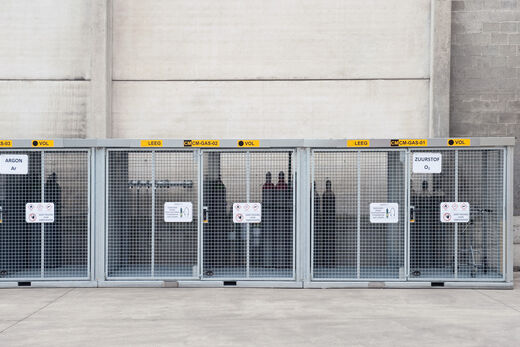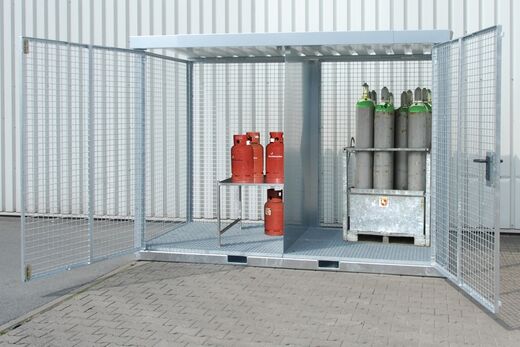Gas cylinder storage guidelines
Gas cylinders may not be stored anywhere. Taking into account the properties of the gases, there are legal regulations on group classification and the layout of the gas cylinder storage area.
Classifying gases by group
Compressed, liquefied or dissolved gases are classified into 4 groups based on their main characteristic. The VLAREM II legislation always refers to those groups. It is therefore important to also list these by type and group to which they belong:
Flammable gases
- gases that are only flammable (F): e.g. acethylene, propane, butane
- flammable toxic (F and T) or flammable noxious gases (F and Xn): e.g. carbon monoxide (CO), ethylene oxide (EO)
- flammable highly toxic gases (F and T+): e.g. arsine, phosphine
Toxic gases
- gases that are toxic (T) or harmful (Xn) only: e.g. ammonia
- gases that are only highly toxic (T+): e.g. phosgene
Oxidising gases
- gases that are only oxidising (O): e.g. oxygen, nitrous oxide
- gases that are either both oxidising and toxic (O and T) or both oxidising and highly toxic (O and T+): e.g. chlorine, fluorine, nitrogen dioxide,...
Other gases not referred to in 1° to 3° above
e.g. argon, nitrogen, helium, krypton, carbon dioxide (CO²)
In a warehouse, each group should have a separate zone, taking into account the distances to be respected between them.
Installation of gas cylinder storage facilities
- You are required to divide gas cylinders of different hazard groups into different storage zones in one storage area. Only gases from the same hazard group are allowed in a zone together.
- Tussen die verschillende opslagzones moet je de minimumafstanden respecteren:
- distance rules for closed storage areas
- distance rules for open storage areas
- Does the minimum distance between groups of gases amount to zero? Then these gases are allowed to be in the same storage zone together.
- Demarcation of the different storage areas is done by: walls, markings on the ground, chains or fixed demarcations at 1m height.
- Want to reduce safety distances from other buildings/warehouses? Then part of the walls can serve as a safety screen.
Need a storage cabinet or container for your gas cylinders?
Leave your details and get all the info you need.

Want more advice?
Contact Laurent Lefebvre
Sales Engineer & Prevention Advisor level 2
Frequently asked questions: Gas cylinder storage guidelines
Yes, empty gas cylinders must also be stored within their respective storage area in a place reserved for this purpose and clearly marked.
No, a storage area must be closed to unauthorised persons. Gas cylinders should only be accessible to authorised personnel.
- The soil should consist of a resistant and impermeable material
- The bottles must be stable - e.g. concrete plinth or other flat base.
- The soil should not be lower than the adjacent terrain and no openings nor cavities or gullies should be present.
- The roof (if present) must be made of non-combustible material and, in any case, may only consist of up to 20 % translucent and self-extinguishing material.
- The walls consist of non-combustible material.
No, in warehouses, it is forbidden to carry out 'overtopping activities', otherwise it is not considered a warehouse.
So only passive storage is allowed.



